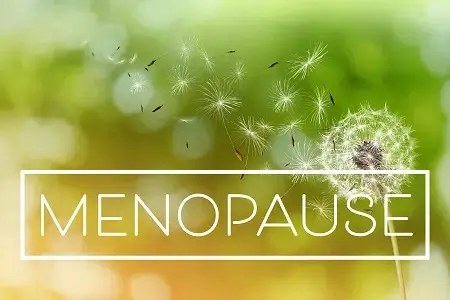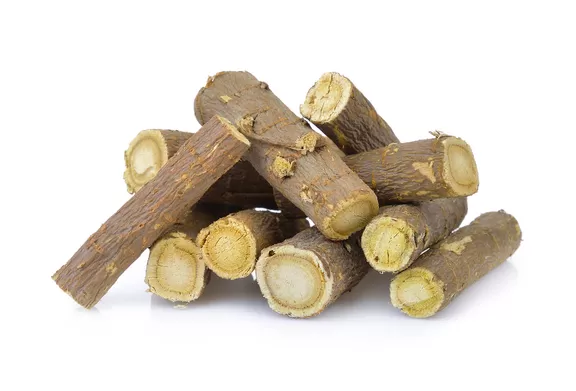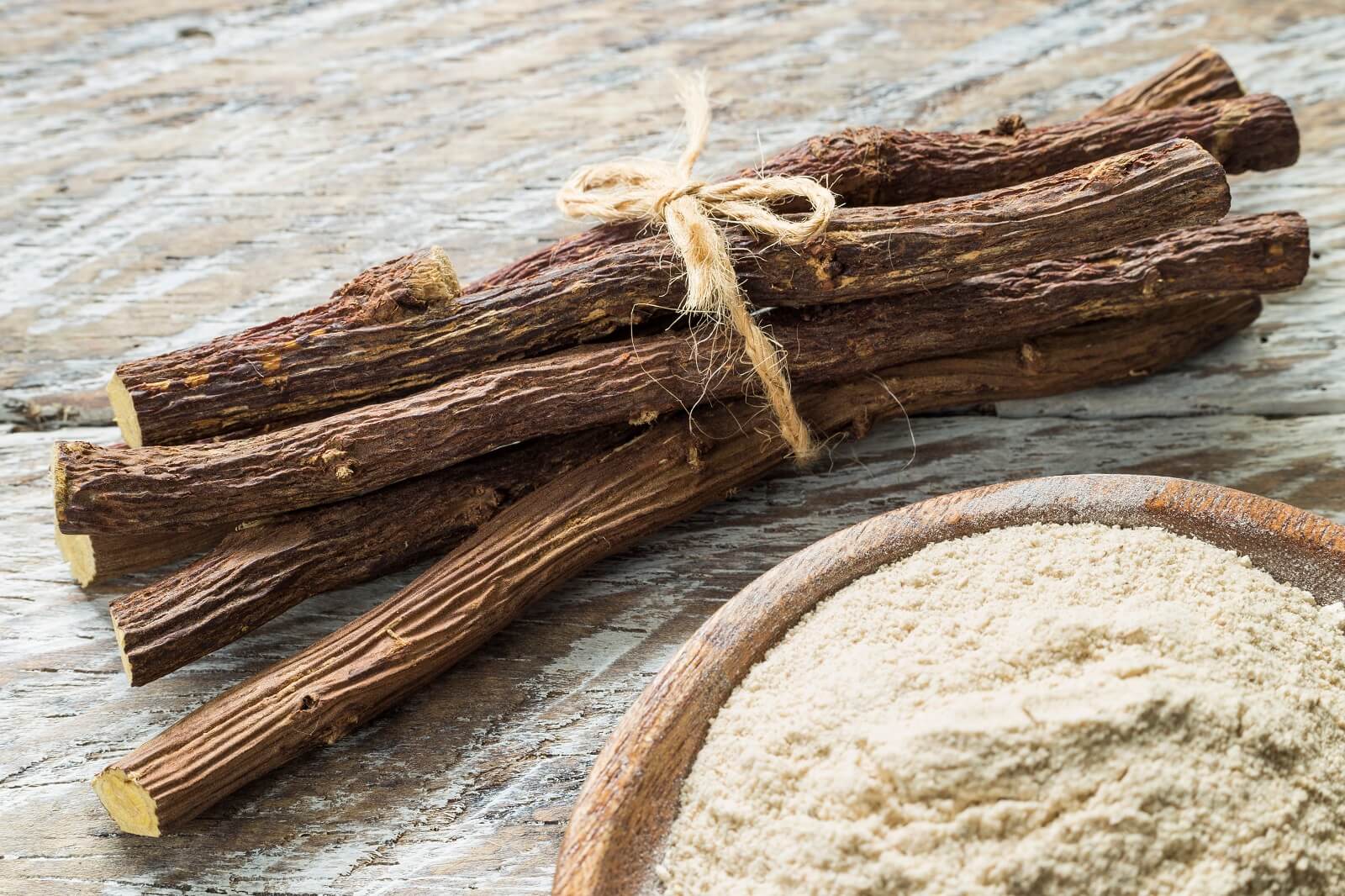
Licorice (Glycyrrhiza sp.) can, in fact, go a long way in helping women in menopause. There are many phytochemicals (plant chemicals) in this herb that act on cellular estrogen receptors; which are what real estrogen interacts with to produce its effects. Licorice can also act as a estrogen receptor antagonist; i.e., it blocks or interferes with real estrogen interacting with these cellular receptors.
For this reason, licorice acts like selective estrogen receptor modulators (SERMs).(source 7) SERMS are used as a treatment for postmenopausal symptoms, breast cancer, and osteoporosis.(source 1)
There are 3 big ways licorice helps with menopause:
- Improves estrogen levels
- Reduces hot flashes
- Helps with osteoporosis
In this article we will be going over the research that indicates licorice can raise estrogen levels, reduce the frequency and severity of hot flushes, and help to stave off osteoporosis. Chemical compounds known as isoflavonoids, flavonoids, and chalcones in licorice are what may be the key reason why licorice can impart all of these exceptional benefits.
But as research will show, teaming licorice up with other herbs might help to drastically improve the effectiveness you get from herbal supplements. One study we will cover later looked at how combining flaxseed and licorice dramatically improved estrogen and progesterone levels in rats who had their ovaries removed.
But, before you start using licorice, please be aware that this herb has some potential side effects. For instance, the glycyrrhizin in licorice, which gives the herb a sweet flavor, can also be dangerous; for this reason licorice can be purchased with this chemical removed.
Also, licorice can interact with many different types of prescription medications. This is because this herb interferes with human cytochrome P450 enzymes (CYP). CYP is used by the body to remove many different foreign substances, such as prescription drugs.
Herbsey has a full article on the side effects and dosage guidelines for licorice that you may want to peruse before you start taking licorice. You can find it here: Side Effects & Dosage Guidelines for Licorice.
Naturally Defeat Menopause Symptoms
If you’ve tried everything, and seen the same old menopause advice; Ms. Julissa Clay, a university medical researcher, invested over 850 hours developing her own natural solution to menopausal symptoms. It works for about 95% of the women who try it.
Find out the unique way Ms. Clay freed herself from these symptoms; backed by a 60 day, 100% money back guarantee.

How Licorice Root Influences Estrogen
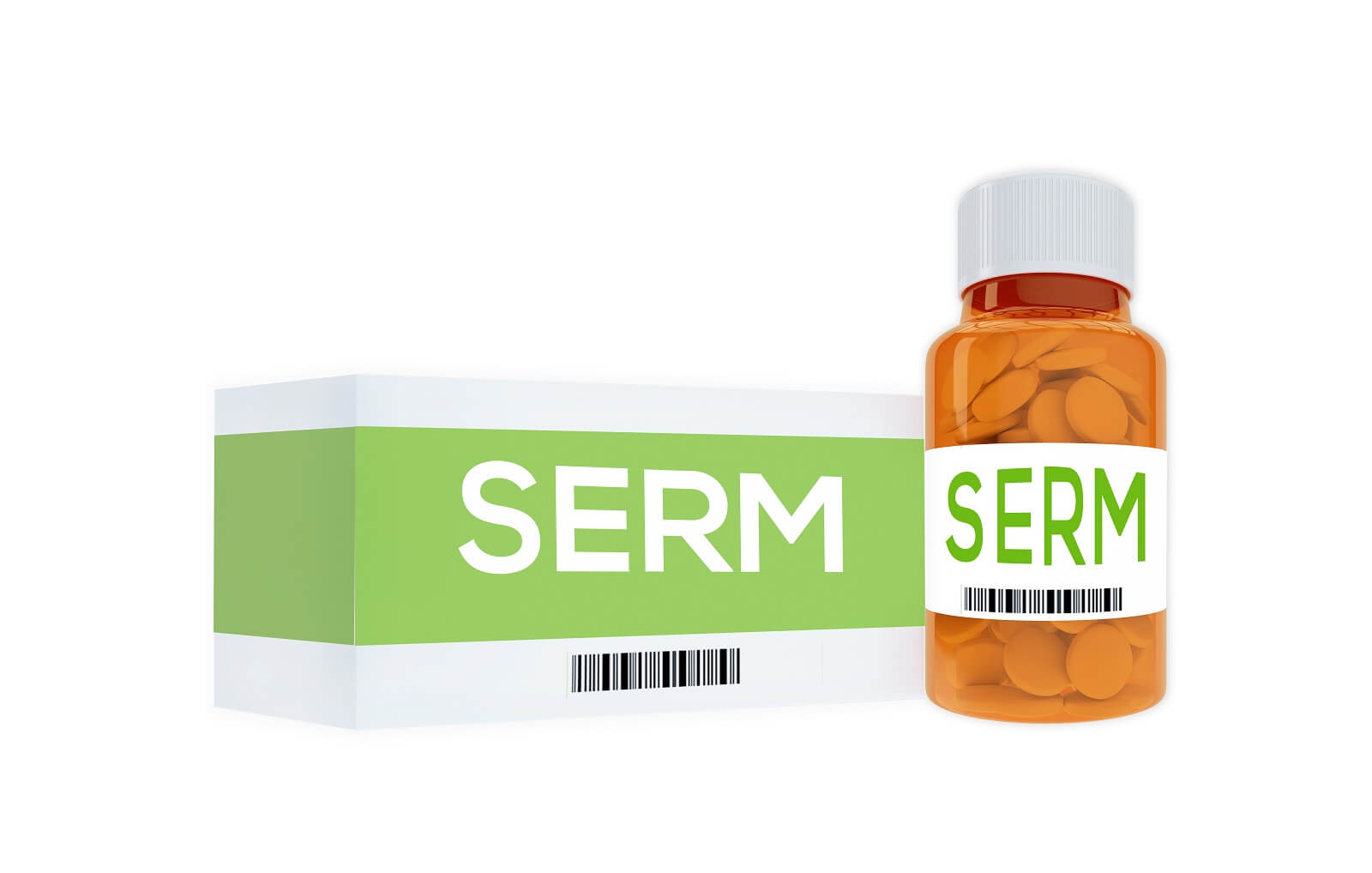
According to Michael T. Murray, ND in the 2020 book Textbook of Natural Medicine(source 2) many herbalists believe that licorice is able to change estrogen levels; i.e., when levels of this hormone are too high, it stops estrogen’s action; and, when estrogen is too low, it increases the power of estrogen’s effects when used in higher doses.
A chemical in licorice, known as glycyrrhetinic acid, is one of the primary bioactive compounds in licorice. This acid is widely used in medicine for the treatment of many diseases.(source 3)
Michael T. Murray states glycyrrhetinic acid has been demonstrated to antagonize (inhibits or interferes with the action) many effects of estrogen; especially estrogens that are taken in and not produced naturally by the body.
Yet, the estrogen-like effect of licorice is said to be due to its isoflavone content. The estrogenic ability of the isoflavones does appear to be more powerful than the estrogen antagonism of glycyrrhetinic acid.
A 2004 study in The Journal of Steroid Biochemistry and Molecular Biology(source 5) looked at two chemical compounds present in licorice: glabridin and glabrene. The study sought to see what kind of estrogen-like activity these substances would have on vascular tissue in a living organism (in vivo) and in a test environment (in vitro).
The study found the most active plant estrogen in their in vivo and in vitro experiments was glabridin. This may be due to the chemical structure commonality between glabridin and 17-beta-estradiol (E2; which is thought to be the most powerful estrogen in humans).
One action that can be carried out when hormones influence the body is the activation of DNA within the cells. In a similar way as E2, glabridin causes endothelial (the endothelium is a thin layer of cells that line the inside of blood vessels and the heart) DNA synthesis. Glabridin also lessened the proliferation of human vascular smooth muscle cells.
The study stated that because glabridin inhibited human vascular smooth muscle cells and caused the proliferation of human endothelial cells it could be beneficial in preventing atherosclerosis (the buildup of plaque within and without the artery walls).
Concerning glabrene, it only stimulated DNA synthesis in vascular cells, but may have a different way of doing this than E2, as it was not stopped by raloxifene (a drug that binds to estrogen receptors thereby blocking estrogen from binding to it and causing changes within the cell).
The amount of glabridin in licorice extract is approximately 0.0965 mg / g.(source 6)
A 2022 study in Nutrition(source 8) summarized the effects of licorice on sex hormones from 28 different studies. The review found that the plant chemicals in licorice had estrogenic activity; especially isoflavonoids, flavonoids, and chalcones.
This finding means that licorice may have a possible use in reducing symptoms of estrogen insufficiency. For this reason it stands to reason it may be able to help reduce menopausal symptoms and help with infertility.
The study also states that licorice can affect the reproductive system. For this reason, you may want to discuss supplementing with this herb with a doctor if you are pregnant or hope to become pregnant. But be cautioned, there are many side effects that can arise from taking licorice, so get professional counsel!
The study also cautioned that due to the wide array of licorice products, this complicated the interpretation of their results.
An interesting 2023 study in Heliyon(source 9) looked at how licorice (Glycyrrhiza glabra) alone and when combined with flaxseed (Linum usitatissimum) oil affected rats that had their ovaries removed.
The study found that treating the rats with a combined therapy of licorice and flaxseed oil helped to:
- Normalize the hormone levels in the blood.
- Improved the thickness and volume of the:
- Mucous membrane lining the uterus (endometrium)
- Lumen (the hollow space inside) volume
- The muscular outer layer of the uterus (myometrium)
- Uterine gland volume
- Vessel diameter
- Fixed the endothelial (the endothelium is the thin layer of cells that line the inside of the blood vessels and lymphatic system) malfunction due to estrogen deficiency.
The study stated the following in their conclusion:
This study showed that a combination of this oil and extract can be used as a complementary and inexpensive treatment for [having the ovaries removed]. It seems that such multi-therapeutic approach can reduce the side effects during menopause and post-ovariectomy problems in women suffering from reproductive diseases and the chemotherapy process.
Heliyon (2023)
Concerning estrogen and progesterone, the study presents the following chart that shows how these two herbs alone and in combination affected these hormones. In the charts notice how the combined therapy mimics how estrogen therapy influences the hormone levels. This is evidence that this combination approach might be a rational alternative to risky hormone replacement therapy.

To understand this chart, the y-axis shows the amount of estradiol (in picomoles / liter), which is the primary female sex hormone. The x-axis shows the circumstances of each group of rats.
The control group did not have their ovaries removed, so their estradiol levels are normal. The sham group had a surgery that did not remove the ovaries, it was a "fake" surgery. OVX stands for ovariectomy, which is a surgery that removed the ovaries.
The other groups are all OVX plus a different treatment. It is assumed that Est indicates estrogen therapy, Lin indicates flaxseed, Gly indicates licorice.
The bar on the farthest right shows what happened to estrogen levels for rats with their ovaries removed who were given licorice and flaxseed.
The p-values shown above indicate various statistical probabilities to verify the legitimacy of the findings.
Image taken from a 2023 Heliyon study. Used under a Creative Commons license (CC BY-NC-ND 4.0).

To understand this chart, the y-axis shows the amount of progesterone (in nanomoles / liter), which is the primary female sex hormone. The x-axis shows the circumstances of each group of rats.
The control group did not have their ovaries removed, so their estradiol levels are normal. The sham group had a surgery that did not remove the ovaries, it was a "fake" surgery. OVX stands for ovariectomy, which is a surgery that removed the ovaries.
The other groups are all OVX plus a different treatment. It is assumed that Est indicates estrogen therapy, Lin indicates flaxseed, Gly indicates licorice.
The bar on the farthest right shows what happened to estrogen levels for rats with their ovaries removed who were given licorice and flaxseed.
The p-values shown above indicate various statistical probabilities to verify the legitimacy of the findings.
Image taken from a 2023 Heliyon study. Used under a Creative Commons license (CC BY-NC-ND 4.0).
Licorice Compounds & Estrogen Receptors

A 2016 study in Steroids(source 7) looked at how 9 different phytochemicals (plant chemicals) in licorice would interact with estrogen receptors. These nine compounds were liquiritigenin, isoliquiritigenin, and 7 other compounds. All of these compounds were either flavonoids, isoflavonoids, or chalcones.
The study found that all 9 compounds bind with estrogen receptors with low affinity. This study showed that these compounds have estrogen agonist and/or antagonist ability; like selective estrogen receptor modulators (SERMs).
A receptor antagonist is the opposite of a receptor agonist. Receptor antagonists bind to receptors and block other chemicals that would bind to it. Instead of activating activity in a cell like an agonist, it does not cause an effect.
The chemicals in licorice that produced the most effect from binding to estrogen receptors was primarily isoliquiritigenin, followed by liquiritigenin, methoxychalcone, and glycycoumarin.
The study concluded by stating:
Thus, while there are reports that various preparations of licorice root may not be effective in moderating the vasomotor symptoms of hot flush, there are reports that botanical supplements containing licorice root or licorice root components may provide estrogen-like benefits to other estrogen target tissues, notably to the cardiovascular system and the metabolic profile, consistent with their tissue-selective SERM-like activity observed in our studies.
Steroids [105 (2016): 42-49]
What Type of Licorice is Best for Improving Estrogen?
A 2013 study in PLoS ONE(source 10) looked at the estrogen-like qualities of hops (Humulus lupulus) and three different species of licorice. The three different species of licorice evaluated were: Glycyrrhiza glabra (G. glabra), Glycyrrhiza uralensis (G. uralensis), and Glycyrrhiza inflata (G. inflata).
The study’s findings suggest that licorice has estrogenic (the ability to act like estrogen) capability in different estrogen sensitive tissues.
Yet, there was a difference in the strength of estrogenic ability between the four species. Starting from greatest estrogenic activity to least, the species were H. lupulus, G. uralensis, G. inflata, and G. glabra. Making the most popular form of licorice, G. glabra, the one with the least estrogenic ability.
This study can therefore help point you to opting for G. uralensis for use in menopause instead of the common G. glabra.
The study found that liquiritigenin was the primary phytoestrogen in the licorice extracts. Yet, licorice and the phytochemicals (plant chemicals) in it have partial agonistic estrogenic activities. And, estrogen agonist is something that activates estrogen receptors to produce a biological response.
Estrogen receptor agonists are primarily used as therapies for menopausal symptoms and as contraceptives.(source 4)
The study stated concerning hops, that the stronger estrogenic ability of this herb could be due to the presence of 8-prenylnaringenin and its precursors.
The study does state that licorice may be more moderate and possibly have safer estrogenic abilities than hops.
End Menopausal Weight Gain
Deborah Murtagh is an international weight loss coach, avid writer and researcher, and founder of several best-selling weight loss programs with thousands of clients in over 48 countries.
Learn Deborah’s ideal plan for losing weight during menopause from a woman who struggled her entire life with weight gain.
Ms. Murtagh’s program comes with a 60 day, 100% money back guarantee.

Licorice Does Help with Hot Flashes
A 2022 study in BioMed Research International(source 11) cited two different studies finding that licorice can help with hot flashes.
The first study involved 60 menopausal women randomly assigned to receive licorice or hormone replacement therapy. The study’s findings indicated that licorice seemed more effective than hormone replacement therapy in helping with the duration of hot flashes.
The second study cited was a 2012 study in the Iranian Journal of Pharmaceutical Research.(source 12) The study involved 90 menopausal women complaining of hot flashes. The participants were randomly allocated into two groups: one receiving 3 capsules containing 330 mg licorice, and the other taking a similar placebo.
The study found that licorice lowered the frequency and severity of hot flashes. The frequency reduction of hot flashes lasted 2 weeks after stopping taking the licorice capsules.
A 2020 study in the Journal of Family Medicine and Primary Care(source 13) cites another study that indicated that licorice reduces hot flashes.
So it does appear that licorice can help with hot flashes!
Dr. John Herzog (MD)
Dr. John Herzog, a "survival surgeon" from Maine explains what home remedies work best in a crisis situation.
This may be important in the event you require first-aid or are in an emergency situation without easy access to a hospital. Dr. John Herzog has assembled a large collection of home remedies for such scenarios.

Licorice can Help with Osteoporosis

A comprehensive review study, published in 2021 in the Journal of Functional Foods,(source 14) investigated a major flavonoid extracted from the root of this herb known as glabridin. One of the pharmacological properties of this compound is an anti-osteoporosis ability.
A 2021 study in Climacteric(source 15) investigated a compound in licorice known as glycyrrhizin and sought to determine how it influenced bone loss in mice with their ovaries removed. The objective was to see if this compound could be a potential treatment for postmenopausal osteoporosis.
The study found that glycyrrhizin had a protective effect on bone metabolism in the experimental mice. The bones of the mice were also studied and the findings indicate that glycyrrhizin helps reduce bone loss.
The study concluded: Our findings imply that glycyrrhizin is a potential efficient adjuvant therapeutic for [postmenopausal osteoporosis].
A 2021 study in the Turkish Journal of Agriculture-Food Science and Technology(source 16) looked at how a ethanol (the same alcohol as drinking alcohol) extract of licorice root affected human osteoblast cells (cells that "build bones").
The osteoblast cells were subjected to various concentrations of the licorice extract for 24 and 48 hours. The results of the study showed that these cells increased their growth when given the licorice extract; and, this increase was statistically significant compared to cells not given the extract.
The study concluded that: [Herbal medicine] applications of licorice root may represent a promising approach in the treatment of periodontal regeneration and osteoporosis.
Claire Goodall’s Amazing Guide
Clair Goodall is a bee-obsessed, natural medicine convert from Minnesota (USA). And, she does keep bees!
Clair has created 350+ page book documenting how to replace the toxic products and medications in your home with healthier, all-natural alternatives.

Using Licorice in Combination with Hormone Replacement Therapy
Licorice is contraindicated for use if you are taking oral birth control pills. This may be due to the fact that licorice can influence sex hormones. Glycyrrhetinic acid, for instance, tends to stop the action of estrogen taken into the body (not naturally produced by the body).(source 2) For this reason, it would be wise to seek the advice of a medical professional before you start using licorice if you are on hormone replacement therapy.
The Side Effects of Licorice
Licorice is an herb that has been extensively studied, and there are well known side effects that can occur when taking licorice. A primary reason licorice causes side effects is due to the chemical glycyrrhizin. Licorice also mimics estrogen in the body, and should be avoided during pregnancy.
If you have heart problems, or are taking blood thinners, make sure you use extra caution when taking licorice. It would be prudent to talk to a medical professional before you begin taking licorice if the aforementioned situations apply to you.
Licorice also inhibits human cytochrome P450; this is an enzyme that metabolizes a wide array of prescription drugs. As a result of this, licorice can cause drug interactions with a wide variety of medications. So, if you take prescription drugs, make sure you consult a medical professional before you take licorice.
Herbsey has an entire article discussing the side effects of licorice. You can find the article here: The Side Effects of Licorice.
A Worry Free, Natural Solution for Menopausal Symptoms
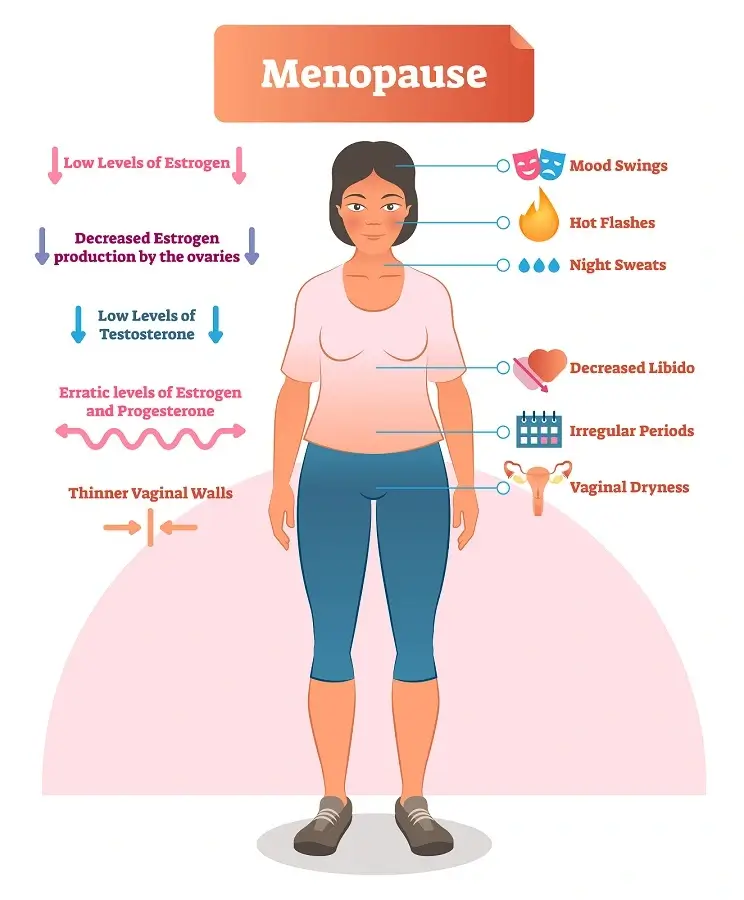
The daunting risks of hormone replacement therapy (HRT), are a reason many women seek out natural alternatives. Julissa Clay was a woman with the same mindset. Although she successfully navigated the symptom perils of perimenopause (the time frame your body starts transitioning into menopause), something unfortunate happened.
Due to problems with her uterus, she had to have it surgically removed. Thankfully, as Ms. Clay says about her surgery: "Luckily, everything went fine and I was lucky enough to walk out of the hospital with nothing but a few puncture wounds from a state-of-the-art surgery."
Yet, soon after entering into surgical menopause she found herself learning what her mother told her hot flashes first hand; plus, her desire for intimacy, ability to keep weight off, and energy reserves were significantly impaired.
She would soon find out these were not residual effects of surgery, this is what many women go through during this important time in their lives.
After trying a host of treatments and internet searches, not to mention eating more soy tofu than a Japanese vegetarian, she hadn’t found a workable solution.
But, Julissa had a secret weapon in her corner: She had spent 5 years as a medical student at a prominent university. So, she knew how to do her research.
Ms. Clay discovered that although you can’t cure menopause, it’s a natural process women go through, you can put a stop to the symptoms that get in the way of quality of life.
Also, Ms. Clay, after learning how to address the symptoms of menopause delved deeper into learning about natural medicine; the end result being so she could synthesize a natural treatment plan that would not keep her up at night worrying about unwanted side effects.
After over 850 hours of research, testing, and refining, Ms. Clay developed a fast and safe solution for menopause symptoms. After testing her program in controlled conditions, 95.4% of women saw it work. And, the 4.6% that it didn’t work for, they lost weight and had more energy as a result.
It may sound too good to be true, but treating menopause is a big business; and, there is little attention probably made to halting the influx of cash by 95.4%.
And, if you want to investigate Ms. Clay’s treatment plan, you can know it is backed by her U.S.A. based publisher’s 60 day, 100% money back guarantee.
If you’d like to learn more about Ms. Clay and her exceptional program, you can find out much more at Julissa Clay’s official program website.
About the Author
Geoff Kent is a natural medicine enthusiast who has been researching and writing about natural medicine since 2008. Geoff is primarily a web developer, but also researches and authors written and video content about natural health. Geoff has a bachelor’s degree in Management Information Systems from the University of Northern Iowa.
More on Geoff KentImportant Disclosures & Disclaimers
It is important to use the information you find on Herbsey.com in the right way. Also for legal reasons, these disclaimers and disclosures are necessary. For further information about each, feel free to click the link provided to the page on this website that provides more information.
Medical Disclaimer
The information on this website is not a prescription for anyone. This information is for informational or educational purposes only, and is not a substitute for professional medical advice or consultations with healthcare professionals.
Advertisement Disclosure
Some of the links provided on this article and website are affiliate links. If you purchase a product after clicking on these links, Herbsey.com will earn a commission. Herbsey.com promotes various products through advertisement and text links. For more information: Our Advertisements.


